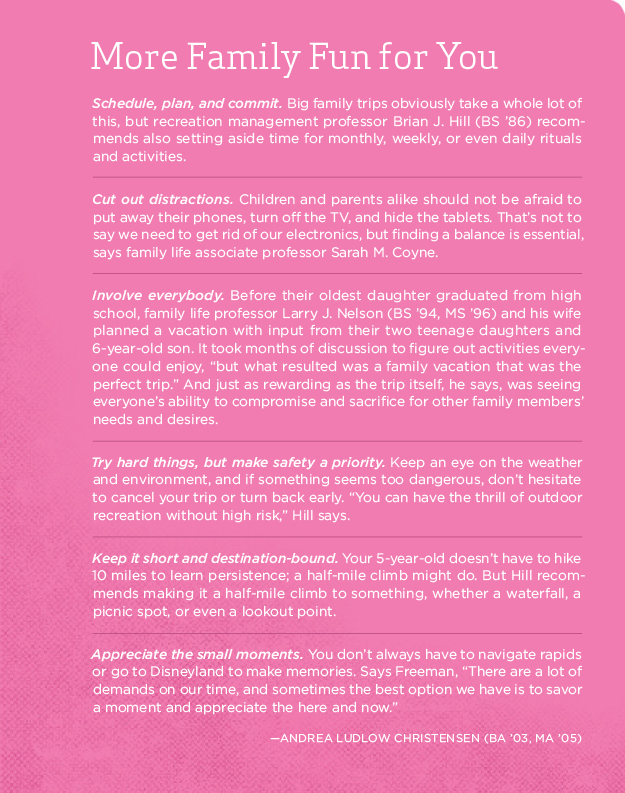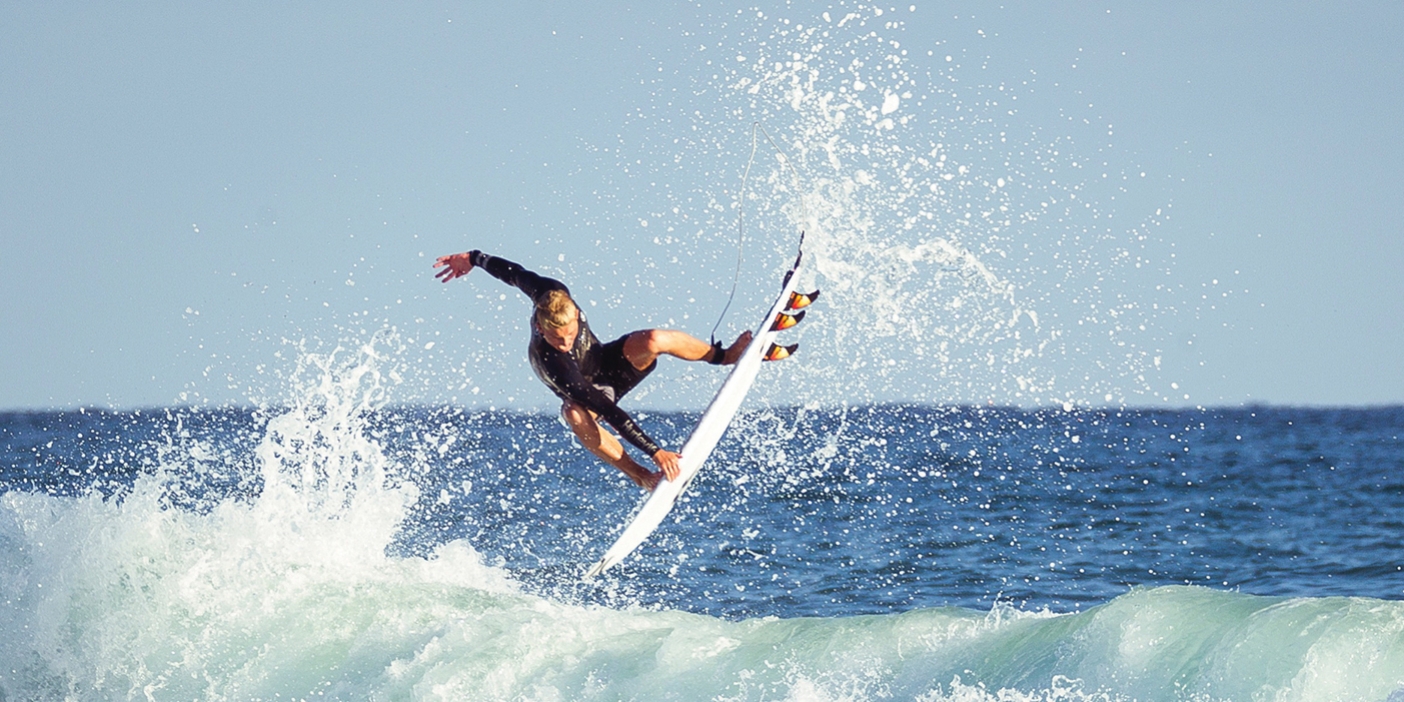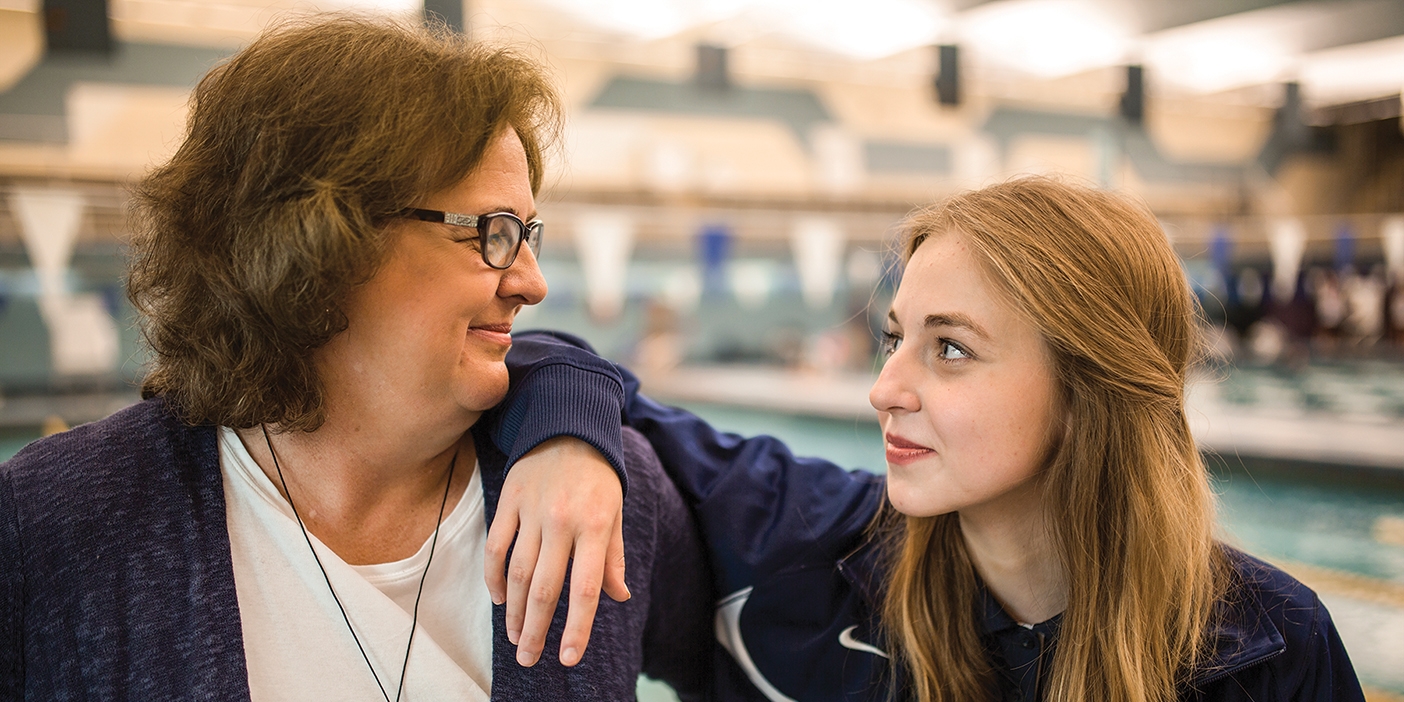Living the Play-Full Life
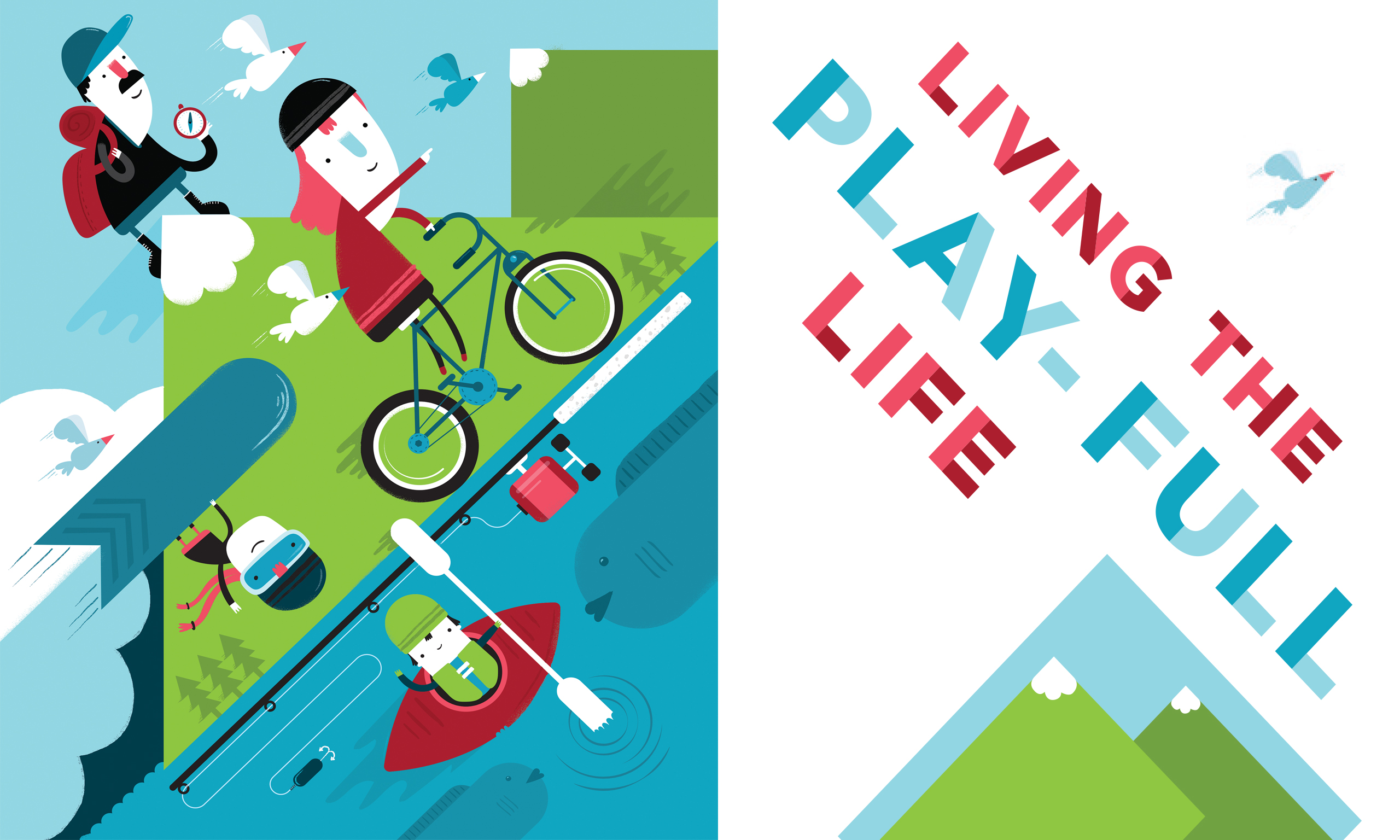
BYU researchers explain how a helping of hard, fun, and awesome can strengthen your kids and nourish your family.
By Andrea Ludlow Christensen (BA ’03, MA ’05) in the Fall 2014 Issue
Illustrations by Shaw Nielsen
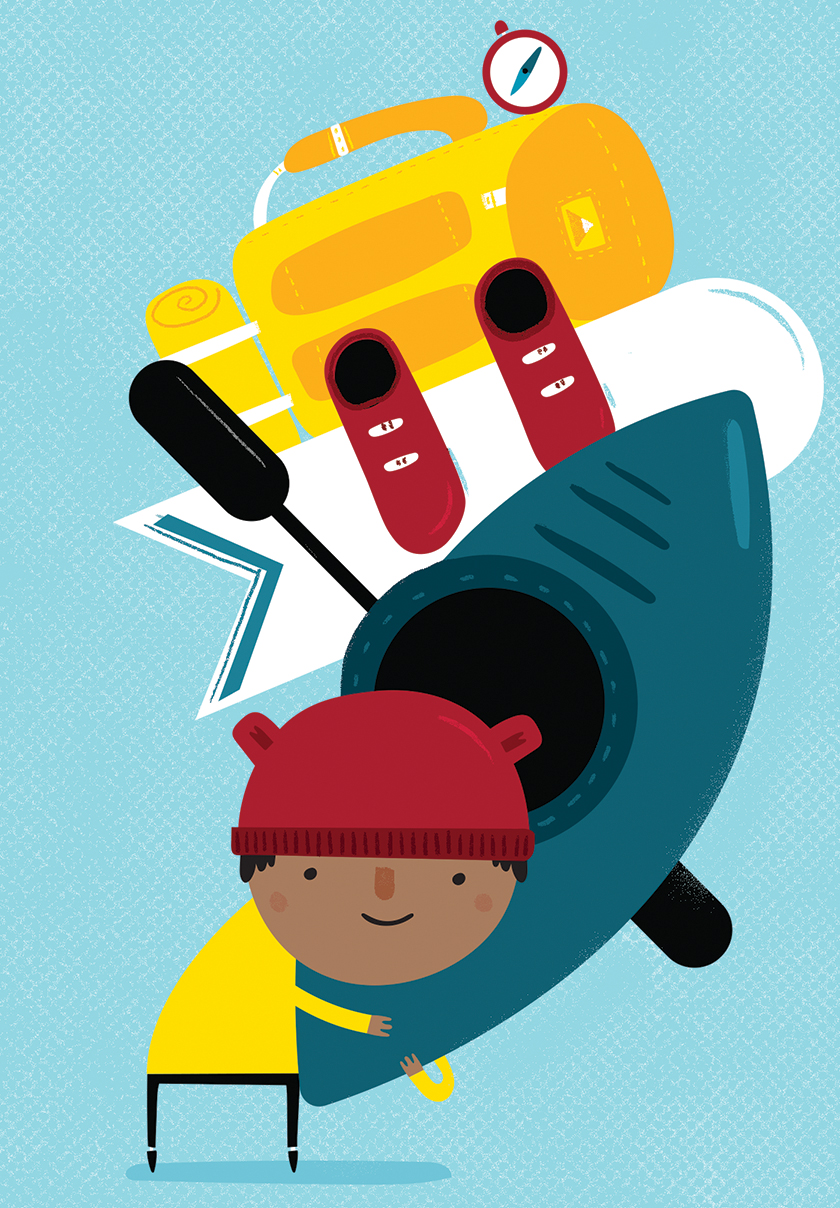
Oversized dress pants cinched around their waists, hair closely cropped, and faces scrubbed clean, Solomon, 7, and his 4-year-old brother, Maxwell, stood beside their aunt and a social worker in the Accra Ghana Temple parking lot. The social worker leaned down and said something in Twi to the boys, who then ran forward, faces lit up, to hug Patti A. Freeman (BS ’88) and her husband, Eric W. Andersen (BS ’01). Freeman and Andersen were meeting Solomon and Maxwell for the second time in six months; this time, adoption finalized, they had come to bring the boys home to Utah. And in those first moments together, Freeman says, “everything was sweet and good. I got goosebumps.”
Five minutes later, when it came time for the boys to go with their new parents, Solomon started wailing, and Maxwell soon joined in. Freeman and Andersen led them to the small temple-grounds apartment they would stay in until they flew home the next day. Maxwell quickly calmed, Freeman recalls, but Solomon was “scared to death.” Over the next few hours, as she and Andersen tried to distract him with games, their new son responded by alternating between running for the front door (blocked by Andersen), crying, and falling asleep exhausted on the couch.
“It was a pretty difficult moment,” Freeman says. “It definitely brought home the reality of ‘Can we do this?’ I was wondering how we would even get him in a car, into the airport, on the plane.”
A visiting missionary suggested Andersen give the boys each a blessing while they slept. And so the night before they were to leave Ghana, Andersen stood over and quietly blessed his sleeping sons. In the blessing to Solomon—the boy with sinewy muscles and a handful of scars from helping feed and support his family—one phrase caught Freeman’s attention: he was blessed to “learn what it feels like to be a child and to play.”
It was an aha moment: “I thought, ‘Oh, we can do that. We can teach him to play,’” Freeman says.
Play, after all, is what she does best. She grew up fishing with her mom, hunting with her dad, and backpacking with her brothers—developing a passion for play and recreation. She jokes that she knew she’d found the right match in Andersen, a part-time ski instructor and fellow outdoors enthusiast, when he said, “Marry me and ski for free.” The two, along with their older twin boys, adopted from Ghana in 2002, had built a life filled with recreation.
For decades researchers have noted the wide-reaching power of play and recreation to teach persistence, build confidence, and improve family relationships, while also warning of broad threats to them: schedules packed with extracurricular activities, media overload, and hovering parents. BYU scholars like Freeman, chair of the Department of Recreation Management, have added strong voices to that conversation—a conversation that has taken on personal relevance for many of them as they have worked to integrate play and recreation into their own families.
In pictures from Solomon’s first days in Utah, his face tilts away from the camera, his wide brown eyes are downcast, and his bright smile is nowhere to be seen. Two weeks in, however, Freeman and Andersen took their boys to the Uinta snow and coaxed them onto small snowmobile sleds. Though Solomon was nervous at first, when his sled took off, he smiled, eyebrows raised, exhilarated. The family rode for hours. “He was soaking wet but didn’t want to get off,” Freeman says. “He just kept laughing and smiling. He felt that joy and thrill that he hadn’t felt with us yet, and it was through play.”
Doing Hard Things
Ryan was exhausted. Halfway through a 3-mile run with his mom, Laura Padilla-Walker, the 13-year-old was groaning and sighing. When Ryan said he wanted to cut across the park and quit early, she encouraged him with a “Keep on keeping on”—their family motto (and also the title of one of her many academic articles). Ryan said he would give it a shot, and the two finished the second half of their route with a slow but triumphant walk-jog.

Padilla-Walker, a family life associate professor who has researched the benefits of adolescent persistence, defines the trait as “the ability to continue toward a worthy goal despite setbacks or obstacles. . . . It’s learning to keep at something you may or may not enjoy, and to not give up just because it gets difficult.”
Play should be fun, but recreation that is also challenging can help kids build persistence, resilience, and confidence—traits that prepare them to hit life’s curveballs.
Outdoor recreation in particular—think hiking, rafting, surfing, skiing, camping—takes place in an environment that has naturally occurring challenges and consequences. “A storm comes in or a tire goes flat, or we fall skiing or learning to ride our bike,” Freeman says. “There are challenges and rewards.”
But the most meaningful rewards come only if parents are willing to let their kids face those challenges. One threat to meaningful recreation and play comes when well-intentioned parents shield their children from reasonable difficulty and risk. “This is the parent who just doesn’t want to let go of the back of the bicycle, because they’re scared to death their child will get hurt,” says Larry J. Nelson (BS ’94, MS ’96), a family life professor who has done research on oversolicitous and overprotective parenting. “If they don’t let go of the bike, the child might not fall and get hurt, but they likewise won’t learn how to ride a bike.”
At its worst, this kind of parenting can stunt a child’s development, says Nelson, a father of three. He points to research that shows that as early as age 4, children with overprotective parents “don’t learn to make decisions for themselves, act for themselves, try new things.” He notes that “they don’t feel good about themselves or their abilities. [Their parents’ behavior] starts to send this message that they’re not capable.”
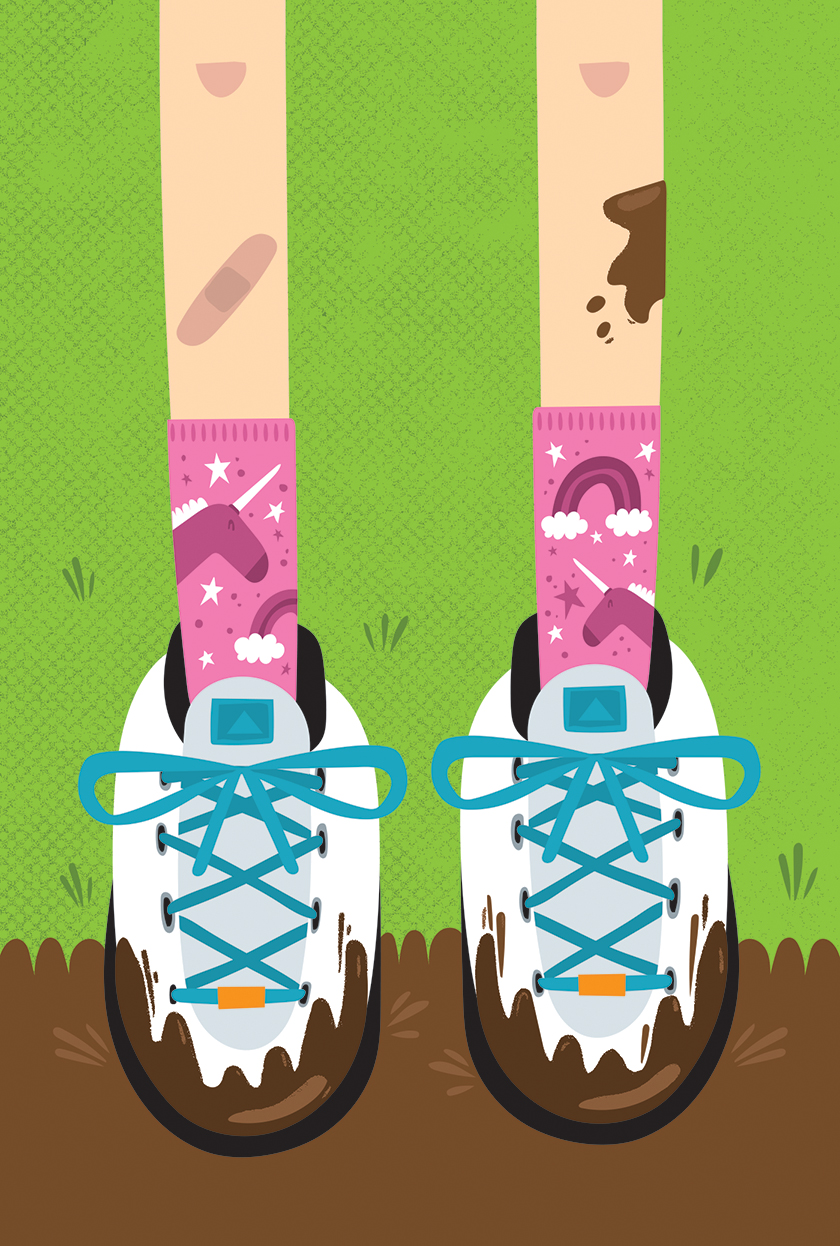
So should parents entirely step back and let their children fend for themselves when faced with an obstacle? Not quite. Nelson encourages incorporating hard but achievable activities into family recreation “with parental encouragement and warmth.”
Recreation management professor Brian J. Hill (BS ’86) also stresses tailoring the level of challenge for individual family members. “If you go beyond what somebody is capable of, now you’ve just frustrated them,” he says. “So [find] that sweet spot between what somebody’s abilities and skills are and a challenge.”
When his four children were young, Hill would break them into backpacking by taking them on a 1-mile hike to a lake. It was hard for the kids, who needed to rest every five minutes, “but it was not overwhelming, and that made a big difference in them wanting to embrace it,” he says. “If families overdo it, it’s a train wreck.”
And when the Hills hiked as a family, rather than coercing, bribing, or using fear tactics to try to motivate those lagging in the back (“You’re going to get left behind, and the bears are going to eat you”), he let them lead and cheered them on along the way.
But even with an appropriate level of challenge and an encouraging parent or family member, some failure is inevitable. A child might biff it on the bunny slope 10 times before nailing a ski run; bad weather might mean a teen needs to turn back before summiting a mountain. And that’s not always a bad thing.
“It’s okay if they fail,” Freeman says. “I think we underestimate the resiliency of our children. We underestimate sometimes what they’re capable of thinking about and doing and trying.”
Building Family Bonds
Hill has a 100-spectacular-outdoor-adventures bucket list, and when the opportunity arose to tackle no. 3—a 60-mile backpacking trip in the central Uinta Mountains—with his two college-aged daughters, he pounced. He tried to mentally prepare his daughters before they left for the weeklong hike’s grueling 25,000 feet of elevation change.
But mountain passes were just the start of their challenges. On the first day of the trip they hiked for hours in the rain and set up their tents in a downpour. “It was just a really high level of misery,” Hill says. That, combined with the challenging climbing, was enough to put 24-year-old Leezanna in a self-described “pain cave.” Though Hill says she didn’t complain, she trekked with her head down, clearly disheartened.
On day two, Hill and 20-year-old Mariah (BA ’12) made it safely across a river bisecting their path. Leezanna fell in. The three had been fairly quiet, focusing on their own challenges. But in that moment, “we looked at each other, and we all just started to laugh,” Hill says.
With that, the mood started to improve: they laughed often and they pushed on, finding a new way to make it up the passes—walk 100 steps, rest 30 seconds, work and rest, again and again. They rejoiced in improved weather and mountain vistas, and in the evenings, they rehashed the day’s adventures over the campfire and played games in their tents.
When they came to their final pass at the base of King’s Peak after five days of climbing, they paused to look back at the series of mountain ridges they had crossed, exhausted but high-fiving. “We were all pretty proud of what we had done,” Hill says. And on the many backpacking trips they’ve taken since, he adds, “we relive something about that epic trek every time.”
That kind of bonding is common to families who participate in challenging recreation.
With a team of BYU researchers, Hill explored whether participating in such challenging outdoor activities as survival adventures or handcart treks would improve communication among families with at least one at-risk adolescent. They found that, rather than arguing more than usual, participating families were kinder and more affectionate, more trusting and supportive, and they finished their experience with new appreciation for individual family members. Many, of course, had moments of conflict and frustration, but they ultimately reported improved communication and family bonds.
Paddle boating on Seattle’s Green Lake with her husband and two preteen children, Padilla-Walker turned adversity into an object lesson. The four rented a boat and headed onto the lake expecting a leisurely family ride, but by the time they got to the middle of the lake, the wind had picked up, making the trip back to shore difficult. Quickly worn out, 10-year-old Ryan and 7-year-old Maggie stopped paddling. But with only Mom and Dad paddling, the boat started spinning in circles.

They explained that the boat wouldn’t move forward unless they all paddled together. “They complained and whined a bit,” she says, “but if they stopped they could see how we would start to flounder.” Working together, they made it to shore.
The paddleboat experience has now become family lore; a metaphor pulled out when parents or kids need help from other family members.
“Parents can draw from these sorts of shared experiences to encourage their children and remind them of the benefits of not quitting,” she says.
And as a family, they can also reminisce about the misery, pain, and—hopefully—successes of those shared adventures.
Unplugging and Planning
Engaging in family recreation is all fine and good in theory, but who’s got the time? BYU researchers acknowledge that planning, facilitating, and executing family activities can take a lot of time and energy—both of which are in short supply these days. “If we’re not intentional about [recreation], we can let time just slip away and other things can infringe upon it,” Freeman says.
One such infringer? Technology. In studies on media use among adolescents and their families, Padilla-Walker and fellow family life associate professor Sarah M. Coyne cite a report that shows 8- to 18-year-olds use media for an average of nearly eight hours a day—or more than 53 hours a week. While Padilla-Walker, Coyne, and other School of Family Life researchers have found that using media together in positive ways can bring families together, an interdisciplinary BYU team found that when individual media use goes up, family interaction and functioning tend to go down.
“If kids are always on their devices and parents are always on their devices, it displaces real, meaningful conversations and fun activities that families can have,” Coyne says. “It’s almost a default for us, . . . and I think we’re giving up a lot of positive things in our lives.”
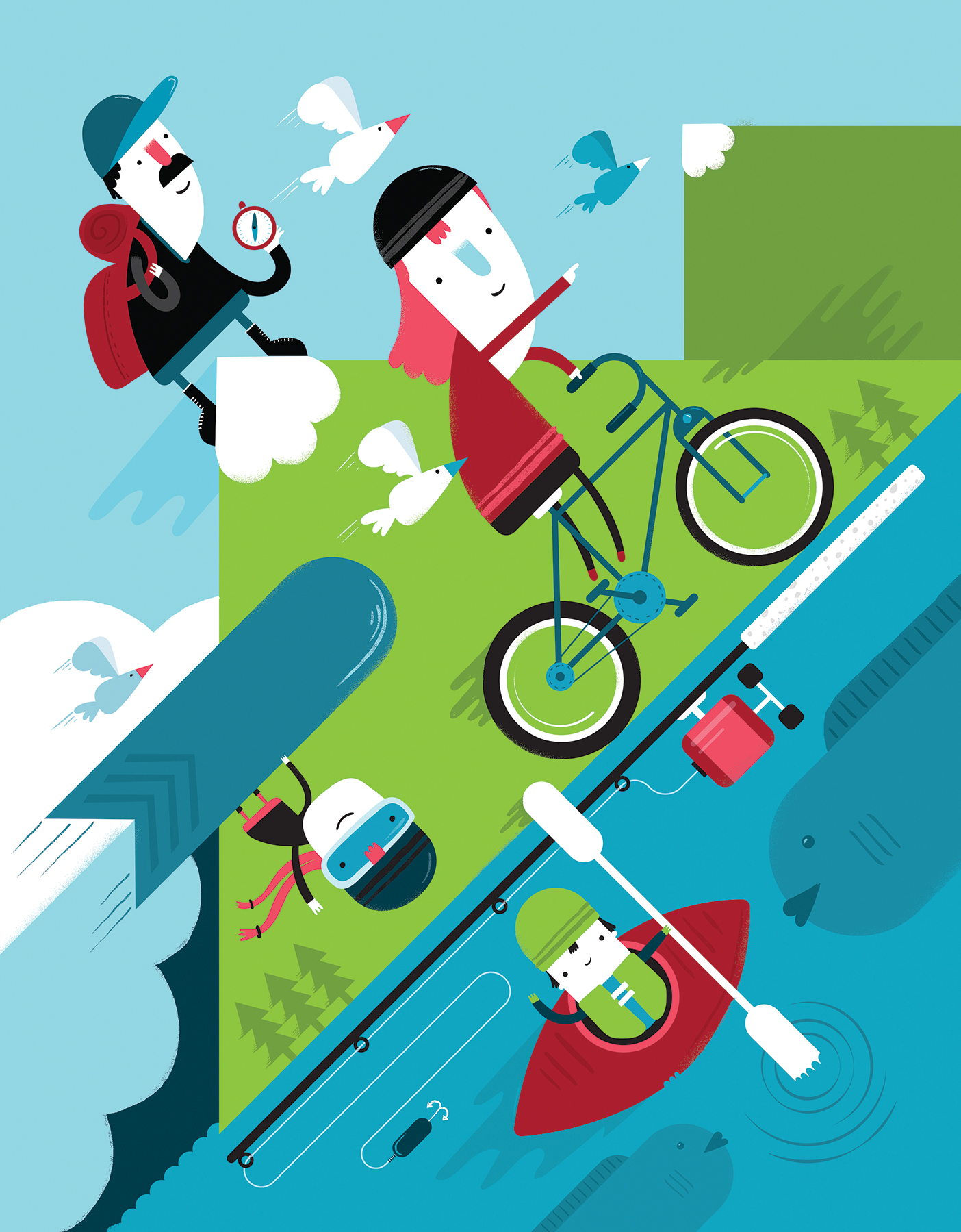
Adds Freeman, “Technology encroaches on everything. If we can’t put boundaries on it, some of our quality face-to-face interactions are threatened.”
Setting media boundaries and even periodically disconnecting are great first steps, but they won’t unlock a magic door into a Norman Rockwellian vision: part of being intentional means creating a space for meaningful recreation to occur, Freeman says. The good news, she emphasizes, is that recreation doesn’t have to be Facebook-worthy to be meaningful.
In a 2009 article Freeman and other BYU researchers explored the impact of both common, everyday family interactions and more-novel, less-frequent family experiences. Both were beneficial and contributed to improved family communication, but the study found that youth perceived the everyday activities as being more significant to their family functioning.
“The things that don’t cost much money and don’t take much time are often the most powerful—things like playing in the leaves, jumping on the trampoline, walking to the park,” Hill says. “We don’t have to spend a lot of money or take long trips to get benefits from family recreation.”
Just a few weeks after coming home from Ghana with Solomon and Maxwell, Freeman was working in her garden when Solomon asked to help. So Freeman gave him charge of a pepper plant, and as they worked side-by-side for the next few months, he opened up to his new mother. In his limited English, he told her about his family—his other Ghanaian brothers and sisters; his father, who died cutting down a tree for wood when Solomon was 5; and his mother, who was then no longer able to care for all of her children.
But the conversation wasn’t always heavy: he liked talking about food—about the fish, turtles, and snails he used to gather for his family and about avocados and pineapple, his favorites. When Freeman told him how much she loved the pineapple in Ghana—“way better than in America”—the boy beamed.
The garden was a peaceful, comfortable place for Solomon during those first few months, Freeman says. “I would purposely sometimes just go outside, and almost always, he would come.”
Their garden time has waned over the past two years as Solomon has developed other recreational interests—he loves Uno and driveway foursquare with the family, and he’s a star soccer player in the local league.
Depending on the activity, Freeman sometimes watches, sometimes joins in, often reminded of the blessing that made her aware of Solomon’s greatest need and always grateful for the “salve of play” that has helped a once-distant and vacant boy learn to trust, bond, and smile.
